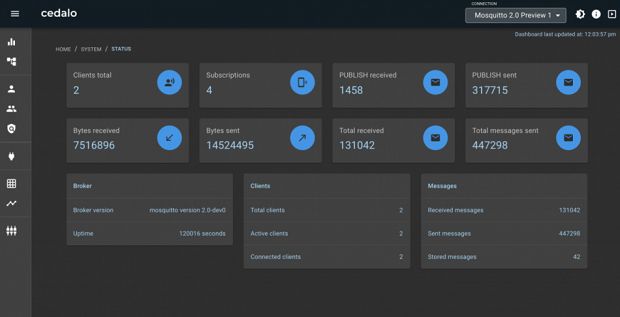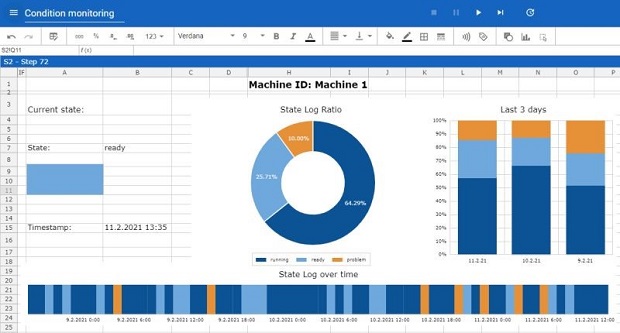Below is our recent interview with Philipp Struss, CEO at Cedalo:
Q: Could you provide our readers with a brief introduction to Cedalo?
A: Cedalo´s mission is to empower engineers as well as businesses to work with real-time data and to create solid infrastructures as well as powerful applications for the IoT and data stream processing. To achieve this goal, we drive the development of two Eclipse projects – Eclipse Mosquitto and Eclipse Streamsheets. Both software technologies are open source with accompanying premium options also available. Our user base ranges from SMEs to major corporations and institutions, such as Siemens, Cisco, Dell, Tibco, and Deutsche Bahn AG.
Q: Can you give us more insights into Eclipse Mosquitto?
A: Eclipse Mosquitto is an open source MQTT broker which enables devices and applications to communicate in real-time on the edge, in the cloud as well as across infrastructures. Thanks to the publish-subscribe communication pattern, individual setups and solutions are not only very scalable but also flexible and can be adapted to changing requirements quickly.
Mosquitto is the most popular MQTT broker in the world with over 9,000,000 docker downloads per month. For instance, it facilitates the message communications within the trains as well as to the control center on all German high speed trains. Recently, we released Mosquitto 2.0 which you can also read more on our website.
Since version 2.0 we also feature a graphical Management Center for Mosquitto to monitor your broker(s) and – most importantly – regulate the IoT security of the connected brokers. IoT security has become a top-notch topic after the reports about hacked cars, household devices, and, of course, industrial IoT communicators. Therefore, version 2.0 of Mosquitto comes with all ports closed upon deployment and a dynamic security plug-in on board. This way security policies and access rights for communication from and to the broker can be changed and set while the broker is running. In addition, the dynamic security plugin is much faster and comprehensive than previous 3rd party solutions since it comes natively with the broker.
Q: What makes Streamsheets different from similar solutions?
A: Streamsheets is a no-code application builder that enables users to create powerful applications to process, merge, analyze and visualize data in real-time. Thanks to the familiar spreadsheet user interface, anyone can create solutions for individual use cases on the edge and in the cloud – without writing any program code.
Streamsheets offer generic functionality. However, typical use cases in the Industrial Internet of Things include for example:
- Connectivity among devices, apps, enterprise software systems, and infrastructures: For instance, Streamsheets are used to transform sensor and machine telemetry data on-premises before sending it to private or public clouds.
- Monitoring and continuous analyses: Another application type comprises the monitoring of machine conditions and production orders as well as continuously calculating and analyzing KPIs.
- Real-time dashboards and visualizations: Thanks to the rich chart options, many of which are also available in the open-source edition, many users create real-time dashboards and individual visualizations.
- Automation: The next step often entails automatically triggering actions which can be as simple as sending alerts while some users go even further and control whole workflows and processes.
Streamsheets makes the creation of full-fledged apps not only possible but also quick and code-free. Other solutions on the market usually require you to have coding skills, e.g., so-called low-code platforms. Here, you can realize trivial to simple applications as no-code applications, but when you want to implement a real-life use case or satisfy your individual requirements, you must program your solution. Streamsheets on the other hand is a true no-code platform that gives you unrivaled flexibility to realize your own logic and visualizations.
Furthermore, you can connect to any API and send as well as receive data via protocols, such as MQTT, KAFKA, OPC UA, and HTTP/REST. Streamsheets also supports databases like MongoDB, InfluxDB, and TimescaleDB, too. You handle incoming and outgoing data by dragging-and-dropping the parts you want to focus on and using spreadsheet functions. This simple procedure already takes away much of the scariness that no-coders often experience when working with data.
Q: What can we expect from Cedalo in the next 6 months? What are your plans?
A: We are constantly upgrading our products to do even more for our users. Thus, you can expect new version releases for Mosquitto and Streamsheets.
In the future, Mosquitto will have stream processing capabilities, meaning that, for instance, you will be able to transform data continuously right on the broker already. One example is aggregations: Assume a sensor sends temperature measurements every second creating a data stream. With the upcoming functions, users can set up transformation rules on the broker. This is interesting if you send data to the major cloud providers which charge you based on this message rate.
Mosquitto will also receive connectors to the IoT suites of the major cloud providers, like Google, AWS, and Azure. Mosquitto will then act as an edge computing buffer for the cloud services. This way you can make the most of the enormous functional breadth of the cloud providers but do not need to be concerned about the connectivity, because Mosquitto will handle that part for you.
For Streamsheets we will add several new functions and diagrams. We plan to have a map graph where you can flexibly associate data in the Streamsheet with a map of your city, or country. Elements such as rivers or certain types of streets can change their appearance based on the underlying data. We think that while a lot of dashboarding systems offer the conventional line, bar, and pie charts, Streamsheets sticks out, when it comes to the graphical representation of your data. The map graph is just another example together with our already implemented state, heatmap, or funnel diagrams.
Integrations of other services that you can access and trigger using new spreadsheet functions will be added, too. Most web services and enterprise systems can be addressed through an API and by sending HTTP requests to these APIs. Currently, you can connect to any API with Streamsheets by sending HTTP requests, but we will make this even easier. Then, you do not have to worry about APIs and how HTTP works instead you can use your favorite web services and enterprise systems through a function similar to SUM() and VLOOKUP(). Sounds great? Let us know what you want to connect to first. We will do our best to integrate it into the first set of integrations!
Q: What’s the best thing about Cedalo that people might not know about?
A: We are truly committed to product-led growth. This means we want our users to be able to test-drive all features we have in our premium editions (nearly) as long as they want. We will therefore soon announce that you can receive a test instance of Streamsheets not only for 14 days (as it is up to now), but we will expand this trial period up to a full year under certain conditions! We believe that the product speaks for itself, but the trial phase should better match people’s needs.
Get started with Streamsheets and Mosquitto and visit our website.
Activate Social Media:


 Recommended:
Recommended:  Recommended:
Recommended: 